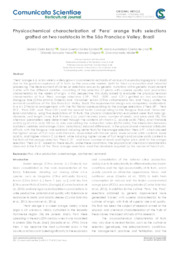Physicochemical characterization of Pera orange fruits selections grafted on two rootstocks in the São Francisco Valley, Brazil.
Physicochemical characterization of Pera orange fruits selections grafted on two rootstocks in the São Francisco Valley, Brazil.
Autoria: BASTOS, D. C.; SOMBRA, K. E. S.; LIMA, M. A. C. de; PASSOS, O. S.; CALGARO, M.; ATAIDE, E. M.
Resumo: ?Pera? orange is a scion variety widely grown in commercial orchards of various citrus-producing regions in Brazil due to the good acceptance of its fruits by the consumer market, both for fresh consumption and industrial processing. The development of clones or selections occurs by genetic mutations within genetic improvement studies with the different varieties, consisting of the selection of plants with superior quality and production characteristics to the variety of origin. In this perspective, this study aimed to evaluate the physicochemical characteristics of four ?Pera? orange selections (?D9?, ?D12?, ?D25?, and ?C21?) grafted on two rootstocks (Rangpur lime (Citrus limonia Osbeck) and ?Volkamer? lemon (Citrus volkameriana Tan. and Pasq.), under the semi-arid conditions of the São Francisco Valley, Brazil. The experimental design was completely randomized, in a 4 x 2 factorial arrangement, with the first factor corresponding to the orange selections (?Pera D9?, ?Pera D12?, ?Pera D25?, and ?Pera C21?) and the second factor corresponding to the Rangpur lime and ?Volkamer? lemon rootstocks, using five replications of 10 fruits. The physical characteristics evaluated were: fruit mass (g), diameter, and length (mm); fruit firmness (Lb), peel thickness (mm), number of seeds, and juice yield (%). The chemical parameters were determined through the contents of vitamin C, soluble solids (oBrix), and titratable acidity (g of citric acid 100 mL-1), also calculating the maturation index (SS/TA ratio). The interaction between rootstock varieties and orange scions (selections) induced differences in the physical and chemical attributes of fruits, with the Rangpur lime rootstock inducing better fruits for the orange selection ?Pera D-9?, which showed the highest values of fruit mass and diameter, associated with thicker peels, lower soluble solids content, lower acidity, and higher vitamin C content, while inducing higher values of fruit length and soluble solids content in the fruits of the orange selection ?Pera C-21?, and lower number of seeds and higher juice yield for the orange selection ?Pera D-12?. Based on these results, under these conditions, the physical and chemical characteristics observed in the fruits of the ?Pera? orange selections meet the standards required by the market of fresh fruits.
Ano de publicação: 2021
Tipo de publicação: Artigo de periódico
Unidade: Embrapa Semiárido
Palavras-chave: Citricultura, Citros, Consumo in natura, Laranja, Laranja Doce, Laranja Pêra, Melhoramento Genético Vegetal, Porta Enxerto, Pós-Colheita, Semiárido
Observações
1 - Por padrão são exibidas publicações dos últimos 20 anos. Para encontrar publicações mais antigas, configure o filtro ano de publicação, colocando o ano a partir do qual você deseja encontrar publicações. O filtro está na coluna da esquerda na busca acima.
2 - Para ler algumas publicações da Embrapa (apenas as que estão em formato ePub), é necessário ter, no celular ou computador, um desses softwares gratuitos. Sistemas Android: Google Play Livros; IOS: iBooks; Windows e Linux: software Calibre.
Acesse outras publicações
Acesse a Base de Dados da Pesquisa Agropecuária (BDPA) para consultar o acervo completo das bibliotecas da Embrapa.

